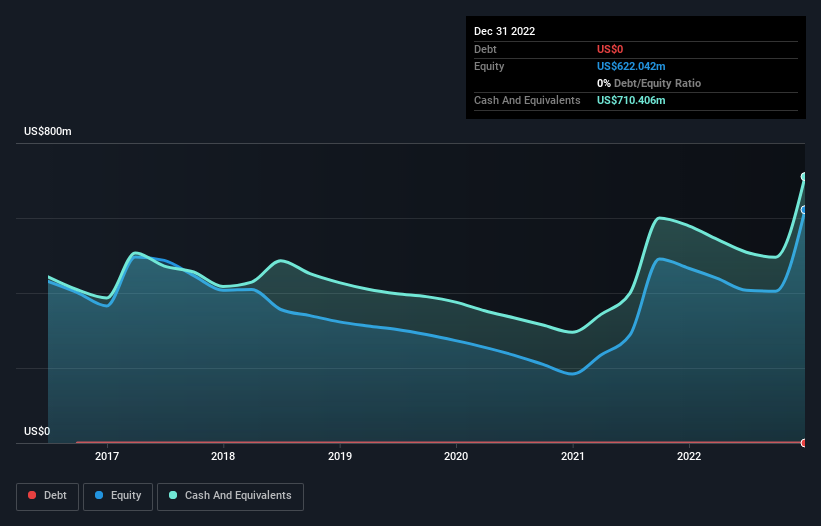- United States
- /
- Biotech
- /
- NasdaqGS:PRTA
We Think Prothena (NASDAQ:PRTA) Can Easily Afford To Drive Business Growth
There's no doubt that money can be made by owning shares of unprofitable businesses. For example, biotech and mining exploration companies often lose money for years before finding success with a new treatment or mineral discovery. But while history lauds those rare successes, those that fail are often forgotten; who remembers Pets.com?
Given this risk, we thought we'd take a look at whether Prothena (NASDAQ:PRTA) shareholders should be worried about its cash burn. For the purposes of this article, cash burn is the annual rate at which an unprofitable company spends cash to fund its growth; its negative free cash flow. First, we'll determine its cash runway by comparing its cash burn with its cash reserves.
Check out our latest analysis for Prothena
SWOT Analysis for Prothena
- Currently debt free.
- Current share price is above our estimate of fair value.
- Shareholders have been diluted in the past year.
- Has sufficient cash runway for more than 3 years based on current free cash flows.
- Not expected to become profitable over the next 3 years.
How Long Is Prothena's Cash Runway?
You can calculate a company's cash runway by dividing the amount of cash it has by the rate at which it is spending that cash. When Prothena last reported its balance sheet in December 2022, it had zero debt and cash worth US$710m. Looking at the last year, the company burnt through US$109m. So it had a cash runway of about 6.5 years from December 2022. Notably, however, analysts think that Prothena will break even (at a free cash flow level) before then. In that case, it may never reach the end of its cash runway. Depicted below, you can see how its cash holdings have changed over time.

Is Prothena's Revenue Growing?
We're hesitant to extrapolate on the recent trend to assess its cash burn, because Prothena actually had positive free cash flow last year, so operating revenue growth is probably our best bet to measure, right now. The grim reality for shareholders is that operating revenue fell by 73% over the last twelve months, which is not what we want to see in a cash burning company. Clearly, however, the crucial factor is whether the company will grow its business going forward. For that reason, it makes a lot of sense to take a look at our analyst forecasts for the company.
Can Prothena Raise More Cash Easily?
Given its problematic fall in revenue, Prothena shareholders should consider how the company could fund its growth, if it turns out it needs more cash. Generally speaking, a listed business can raise new cash through issuing shares or taking on debt. Commonly, a business will sell new shares in itself to raise cash and drive growth. By comparing a company's annual cash burn to its total market capitalisation, we can estimate roughly how many shares it would have to issue in order to run the company for another year (at the same burn rate).
Prothena has a market capitalisation of US$2.9b and burnt through US$109m last year, which is 3.8% of the company's market value. That's a low proportion, so we figure the company would be able to raise more cash to fund growth, with a little dilution, or even to simply borrow some money.
How Risky Is Prothena's Cash Burn Situation?
As you can probably tell by now, we're not too worried about Prothena's cash burn. For example, we think its cash runway suggests that the company is on a good path. Although we do find its falling revenue to be a bit of a negative, once we consider the other metrics mentioned in this article together, the overall picture is one we are comfortable with. There's no doubt that shareholders can take a lot of heart from the fact that analysts are forecasting it will reach breakeven before too long. Taking all the factors in this report into account, we're not at all worried about its cash burn, as the business appears well capitalized to spend as needs be. Its important for readers to be cognizant of the risks that can affect the company's operations, and we've picked out 2 warning signs for Prothena that investors should know when investing in the stock.
Of course Prothena may not be the best stock to buy. So you may wish to see this free collection of companies boasting high return on equity, or this list of stocks that insiders are buying.
New: Manage All Your Stock Portfolios in One Place
We've created the ultimate portfolio companion for stock investors, and it's free.
• Connect an unlimited number of Portfolios and see your total in one currency
• Be alerted to new Warning Signs or Risks via email or mobile
• Track the Fair Value of your stocks
Have feedback on this article? Concerned about the content? Get in touch with us directly. Alternatively, email editorial-team (at) simplywallst.com.
This article by Simply Wall St is general in nature. We provide commentary based on historical data and analyst forecasts only using an unbiased methodology and our articles are not intended to be financial advice. It does not constitute a recommendation to buy or sell any stock, and does not take account of your objectives, or your financial situation. We aim to bring you long-term focused analysis driven by fundamental data. Note that our analysis may not factor in the latest price-sensitive company announcements or qualitative material. Simply Wall St has no position in any stocks mentioned.
About NasdaqGS:PRTA
Prothena
A late-stage clinical biotechnology company, focuses on discovery and development of novel therapies to treat diseases caused by protein dysregulation in the United States.
Flawless balance sheet and slightly overvalued.
Market Insights
Community Narratives




